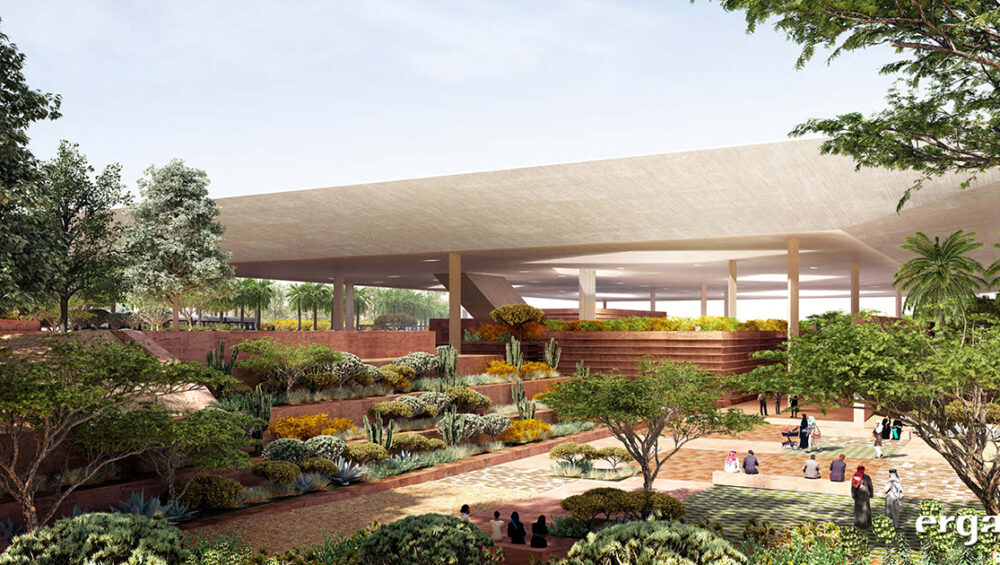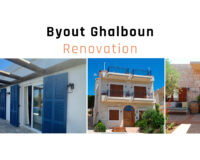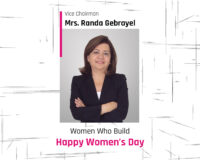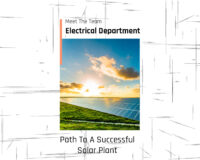The Visitors’ Pavilion, located in the heart of Riyadh’s King Salman Park (KSP) masterplan, is envisioned as a new landmark project and a public realm.
The KSP Visitors’ Pavilion is a sustainable project designed to fortify the city’s cultural regeneration and thrive oasis in the desert.
It works to cool the air through a labyrinth under the courtyard and a double-skinned canopy of approximately 16,000sqm to provide a refreshing environment and adequate thermal comfort in the pavilion.
Its welcoming parcel of approximately 41,000sqm welcomes public and VIP visitors via a majestic entrance pavilion with the diamond motif echoed in the scheme’s structural columns and slab apertures. A diamond-shaped waffle slab system gave the entrance, dining, conference, and auditorium pavilions a distinguished touch.
The indigenous beauty of Saudi Arabia’s natural heritage draws visitors to the Rammed Earth Walls.
It is embodied in its flexible auditorium, retail stores, restaurants, library, conference, reflective pools, exhibition, and wellness areas.
Visitors ascend via staircases and escalators in a massive prism that connects all of the amenities to the sky pavilion. They enjoy breathtaking views of the master plan from the massive rooftop platform that spans the entire project footprint.
Erga’s scope of work included pavilion structure design, landscaping, civil works, and mechanical and electrical design. In close collaboration with the architect Adjaye Associates, the upper canopy designer Buro Happold, and several sub-consultants, a complete engineering construction package was prepared.
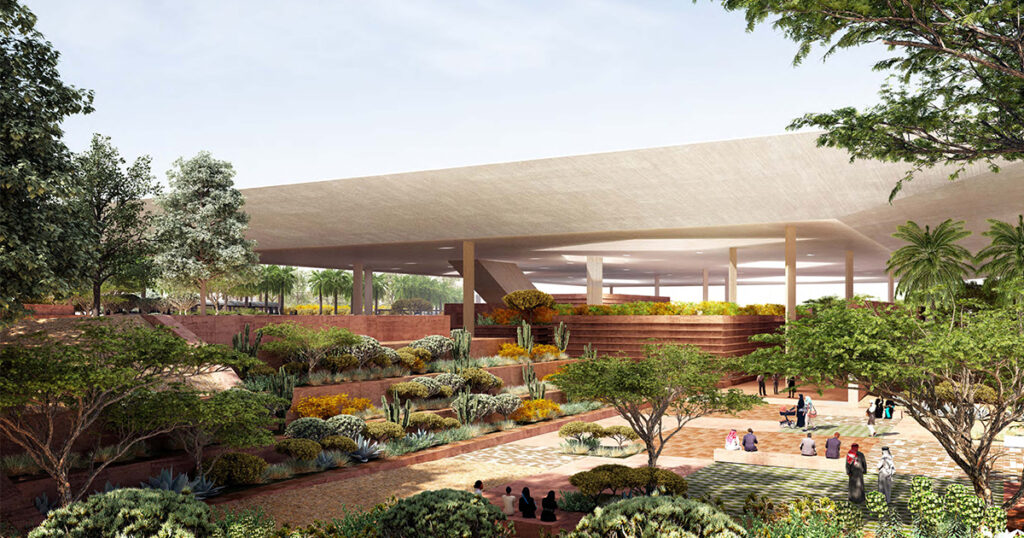
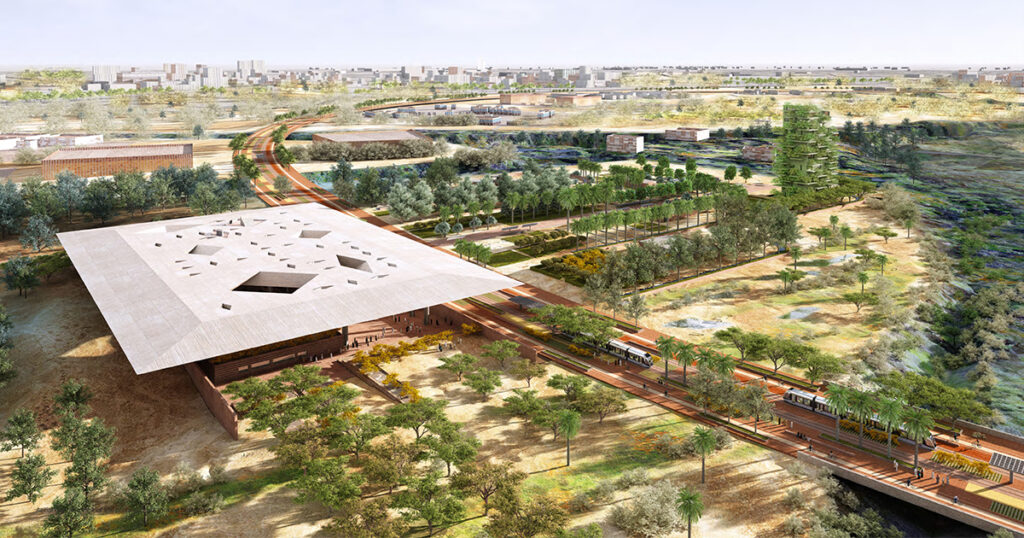
Structural
Erga’s structural engineering scope comprised the design of five pavilions, a common basement, external service structures, and surrounding landscaping areas. Hereafter is a list of some particular issues that were tackled during the design process.
- Diamond shape waffle slabs were designed with three directional patterned beams including openings to allow for all MEP systems and requirements.
- A post-tension slab system, supported jointly by upper canopy and pavilion structures, was adopted for the entrance building due to large spans and architectural constraints.
- Bearing pads were provided in several locations in order to avoid unfavorable structural interactions and additional stresses.
- Expansion joints were provided in order to reduce self-straining loads and to avoid extreme connection stresses, considering pavilions and upper canopy’s displacements.
- The structural design considered rammed earth requirements and special relevant details.
- Due to the projects’ natural cooling concept, the structural elements supported overburden loads and included a series of walls and slabs’ openings to cope with underground pipes’ routing, labyrinth layout, architectural and MEP requirements.
- Foundations’ design was accomplished through a detailed superposition of all gravitational and lateral pavilions and upper canopy loads.
Mechanical
The aim of the Mechanical design was to provide mechanical engineering services (HVAC, Plumbing, Irrigation, Fire Fighting), BMS (Building Management System) systems in addition to BOQ (Bill Of Quantities) and Specifications (CSI format) for the Visitors’ Pavilion, King Salman Park.
The Mechanical systems were designed to offer the best in terms of comfort, reliability and safety. Systems are also easily maintainable and efficiently operational.
The mechanical systems are divided into five parts:
Plumbing
- Storm water drainage collecting roofs and terraces and then discharging by gravity into the storm network.
- Sanitary sewer drainage designed as 2-pipe system, soil/black collecting WCs, urinals and kitchens and then discharging by gravity into the sewage network where gray/waste collecting wash basins/lavatories, ablutions, showers and floor drains and then discharging by gravity into the gray treatment plant.
- A booster pump supplying domestic cold water from the water storage tank to each pavilion wet areas with adequate flow and pressure at each sanitary fixture. A water softener filtration system was used supplying through booster set soft water for the dining pavilion main kitchen and the kitchens of the food court kiosks.
- Domestic hot water was provided by means of two independent set of central electric water heaters feeding each set the dining pavilion and the wellness pavilion. Dedicated hot water storage tanks for the soft water were provided for supplying the dining pavilion main kitchen and the kitchens of the food court kiosks with soft hot water. All remaining toilets and kitchens in each pavilion, were provided with independent dedicated electric water heaters.
- Hot water return circulation pumps were provided for the central electric water heaters to insure instantaneous hot water at the most remote tap.
Irrigation
- The irrigation water tanks of the project were fed directly from the KSP tie-in point TSE water network and filled also from gray/waste effluent water.
- Each green zone was irrigated according to the type of planters, shrubs… via motorized valves connected to a central irrigation control system.
Fire Fighting
- All areas throughout the project and the MEP service tunnel was designed with fully sprinkler.
- Class II (hose reel) and Class III (LV + hose reel) standpipe was distributed throughout the project.
- The whole firefighting system was supplied from the domestic water tanks, through set of fire pumps one electric driven and one diesel driven (one duty and one stand-by) with one jockey according to NFPA 20.
- Fire department connection (Siamese inlet breeching) was provided for sprinkler and standpipe system.
- Fire dampers were distributed throughout the project.
- Portable fire extinguishers were distributed throughout the project.
- NOVEC-1230 & FOAM automatic fire extinguishing system was provided for the hazardous areas.
HVAC
- The cooling load calculation was done through the Energy Performance Analysis Software (IES-VE).
- The dining pavilion was cooled by means of two air handling units (AHU) for the big dining area and fan coil units (FCU) for the medium/small areas.
- The auditorium pavilion was cooled by means of two air handling units (AHU) for the auditorium area and fan coil units (FCU) for the medium/small areas.
- All remaining pavilions were cooled only by fan coil units (FCU).
- Each pavilion was provided by energy meter on the chilled water system, their AHUs and FCUs were fed from the KSP district cooling chilled water network.
- Thermostat and control were provided for each indoor unit.
- Constant airflow was distributed inside each space by means of ducting and air outlets.
- MEP rooms were provided with independent FCUs where necessary.
- All enclosed spaces were adequately ventilated.
- Treated fresh air, through 100% fresh air AHUs, was provided for supplying the indoor spaces in all pavilions.
- Fresh air amount was set to result an overall positive pressure in each pavilion. toilets & kitchens were always under negative pressure toward the surrounding spaces.
- Energy recovery was provided for the pavilions air conditioning system, cooling was exchanged between exhaust air and fresh air through energy recovery wheel (100% FAHU) thus reducing the total building cooling load and achieving a great amount of energy saving and reducing therefore the building running cost.
- Treated fresh air was provided for all pavilions indoor spaces by the 100% FAHU.
Building Management System (BMS)
Building management system for the electro-mechanical systems was provided allowing full control of all equipment from the system and status, alarm and fault indication of equipment as well as high and low level alarms of all water tanks and sump pits, in addition it will operate in a most optimum and energy efficient mode.
Electrical
The aim of the electrical design of King Salman Park was to provide a high level of service with maximum availability while conforming to the local and international standards and life safety requirements.
Bill of Quantities and specifications were prepared in compliance with the latest AIA Master spec format and issued for tenderers.
The electrical scope is separated into three parts:
Power Design
- It starts from the Medium Voltage sidestepped down to Low Voltage with backup from emergency generators that supply the essential and life safety loads in case of emergency or power failure.
- Critical loads were supplied From redundant Uninterruptible Power Supplies (UPSs).
- Calculations were made using international software.
- Smart panels were specified for the control and protection of the electrical installations.
- Earthing and Lightning protection were designed to protect the human and the structure.
Lighting
- Normal and emergency/anti-panic lights are both covered.
- Indoor, landscape, and façade lighting were all designed completely, including simulations and calculations.
The ornamental and non-decorative lighting fittings were chosen in collaboration with Adjaye, the project’s International Architect.
Low Current
- A fire alarm system was designed for the complete project providing early fire detection.
- Data communication and structured cabling, as well as the selection and specifications of active IT components and Wi-Fi heat map designs, were developed. The Satellite Master Antenna distribution is the same.
- Complete Audio-Visual studies were made based on the latest high-end technologies. Same for the Surveillance and access control systems.
Landscaping
The scope of the above work included interior and exterior landscaping, hardscape, streetscape elements including but not limited to plazas, decorative pavements, environmental graphics, and irrigation systems as required, coordination and interface of the irrigation system with site-wide utilities, landscapes, and hardscape such as paving materials, planters, benches, fountains, display boards, flag poles, etc. In addition, the design provided coordination of all wet-scape elements such as water features, fountains, etc.
Coordination with the Main Consultant covered the choice of trees, ground cover, landform, paving and materials, and hardscape elements.
Irrigation systems complete and associated automatic control systems, Outline maintenance program, Specifications, Calculations, and BOQs were also provided.

